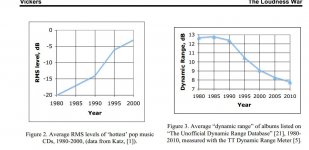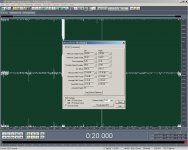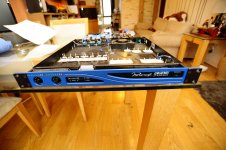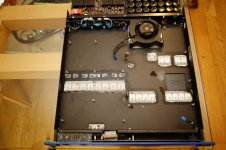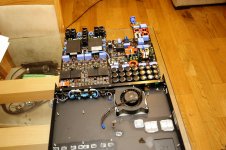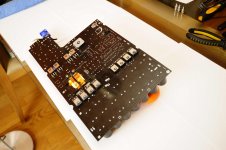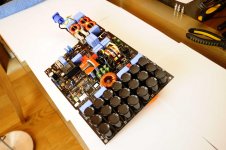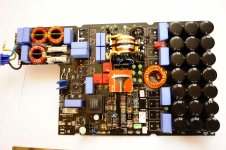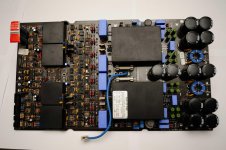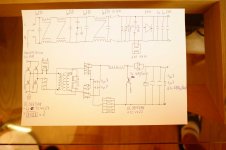So, do I just need PKN amplifier, a sound card and a bit of space on the desk (2U rack size?) to create a 55 horsepower Variable Speed Drive, that would otherwise weight like 150kg and take a cubic meter or so? Come on...
(1U rack! 1 cubic meter? Come on! We are not in the early 80's!)
Do you sleep on tables? Do you eat with screwdriver? Why would you use something for what is not intended to used for?
Evolution: specialisation! Amplifier is SPECIALISED for driving speakers, specification is also specialised! The more specialisation, the more it is cost-efficient, and the less it is usable for everything that is not intended to used for.
Instead of making meaningless comparisons try to understand the specifications, and read them CAREFULLY! Ignoring written facts doesn't lead to anywhere. (For example that UPS is isolated, and capable of making 100 kVA for one cycle.)
Instead of irrelevant similarities one should deduce from basic phisics and usual values.
For example: there is 80 VDC on DIGAM7000's outputs. This is the half of the power supply voltage, so Vdd=160 V. Loaded by 2 ohms makes it lower, probably by 25%, but still there is 120 V. On output FETs drop for example 2 %. This means 3457 W sinus output power on 2 ohms. Current is 120/2=60A. Is it unbelievable? No! 2 pcs of IRFB4227 can carry it very easily. Does the amp capable of sustain this for a long time? No. Is it required? No! Normal people don't want to fry their speakers, they want to listen to music.
3-level IGBT inverters and other efficiency tricks which could hardly be used in fullrange audio amp
I don't know what trick do you mean, but 3 level (and 5 level) PWM is used for ages in audio power amps also. IGBT is also used sometimes, however oversized MOSFETs are better for this voltage levels.
Last edited:
Pafi, try focusing some more next time since you've missed some points I was trying to make.
I was asking provoking rethoric questions and didn't expect them to be answered at all, especially that way, trying making one think instead.
I don't need to re-read the specs because I've opened the gizmo and gone component after component and I know well how it's made. Not isolated BTW.
Music? Do you really believe that old 1/8 power belief? Modern music (electronic, rock, metal, pop,...) has dynamics of 0.5 to 1dB. It's RMS versus peak may be actually higher than the ratio of a sine, which is 0.707.
3 level inverters for audio? are we talking the same thing?
http://powerelectronics.com/images/partitioning-eases-fig-3.jpg
I was asking provoking rethoric questions and didn't expect them to be answered at all, especially that way, trying making one think instead.
I don't need to re-read the specs because I've opened the gizmo and gone component after component and I know well how it's made. Not isolated BTW.
Music? Do you really believe that old 1/8 power belief? Modern music (electronic, rock, metal, pop,...) has dynamics of 0.5 to 1dB. It's RMS versus peak may be actually higher than the ratio of a sine, which is 0.707.
3 level inverters for audio? are we talking the same thing?
http://powerelectronics.com/images/partitioning-eases-fig-3.jpg
....
Music? Do you really believe that old 1/8 power belief? Modern music (electronic, rock, metal, pop,...) has dynamics of 0.5 to 1dB. It's RMS versus peak may be actually higher than the ratio of a sine, which is 0.707.
3 level inverters for audio? are we talking the same thing?
....
Although there are a few bits of recordings that have less than 10 db of dynamic range, there are not many.
Then again if you are listening to those selections, distortion of the amplifier or even other parts of the reproduction change is only an issue to be sure there is enough to achieve the desired effect.
Major sound tours will accept a minimum of 10db headroom but 20 db is more than enough except for live symphonic music which tops out at 30 db.
Now dynamic range is different than headroom. Headroom means that if the sound level meter reads 100 db on the actual music then the system should be able to do 110 db before things break to get a 10 db rating. (At 110 db it will sound and actually be distorted.)
A dynamic range of 10 db means that when the meter reads 100 db even an oscilloscope will show an input voltage range of less than 3.16 to 1.
Generally you're right, although I've frequently encountered heavily compressed with the average RMS of the waveform in the -8dB to -7dB range, a pure peak-to-peak sine being -3dB.
I am talking about mastered CD versions, which are still not as bad as radio/TV broadcasted or some live clipped music (yes, many live sound engineers clip a lot, some do at studio too).
Edit, found something interesting:
http://www.sfxmachine.com/docs/loudnesswar/loudness_war.pdf
I am talking about mastered CD versions, which are still not as bad as radio/TV broadcasted or some live clipped music (yes, many live sound engineers clip a lot, some do at studio too).
Edit, found something interesting:
http://www.sfxmachine.com/docs/loudnesswar/loudness_war.pdf
Attachments
Last edited:
Pafi, try focusing some more next time since you've missed some points I was trying to make.
Those points are confused, left untold, based on false believes, this because I deliberately not focused on them. Instead I tried to show the correct way of thinking.
I was asking provoking rethoric questions and didn't expect them to be answered at all, especially that way, trying making one think instead.
You should think first, and if you reached a proven conclusion, then share it! Don't expect others to think the same you do!
I don't need to re-read the specs because I've opened the gizmo and gone component after component and I know well how it's made. Not isolated BTW.
So you say your link contains false informations? Ruining your own sources don't help I think. What remains then? Believing everything you say (oops, no: what you expect to think without saying) just because you said it?
Music? Do you really believe that old 1/8 power belief?
No, I dont. I measured 1/4 (extreme!) to 1/40. Additionally the resistance of voice coil goes higher at high power (temperature). And impedance grows further in the typically used range in case of woofers, what makes sustained power demand even lower. And if some crazy person would like to listen to pure sine wave, then he need to purchase 4 times higher power rated speakers than the actual power.
Modern music (electronic, rock, metal, pop,...) has dynamics of 0.5 to 1dB.
Dynamics is an irrelevant feature in this respect. Crest factor is the important. I hope you know the difference, and this debate is not based on a misinterpreted "measurement".
It's RMS versus peak may be actually higher than the ratio of a sine, which is 0.707.
"Maybe" worths nothing! Measure, or believe others, who measured instead of guessing! I can easily generate a signal with 0 dinamics and 1/10 RMS/peak value.
3 level inverters for audio? are we talking the same thing?
http://powerelectronics.com/images/partitioning-eases-fig-3.jpg
Of course not. Do you think this is the only way of realising multilevel PWM? It is not. It can be done with full bridge, or BCA topology, and can be extended further to any level without impractical series connections. Old story. And can be controlled much easier then this.
Edit, found something interesting:
http://www.sfxmachine.com/docs/loudnesswar/loudness_war.pdf
I searched that Metallica song,
Metallica - My Apocalypse (Live Premiere 2009) - YouTube
and after a light overload I measured 40 % RMS/peak value (in voltage), which means 0.16 in power, so RMS/nominal_sine power is 0.32 for this song. This can appear to be high, (however still very far from what you thought), but after low pass filtering to 200 Hz (since nobody use 1 way PA system at this level) the result is a much lower value, about 0.1! If you want, you can do this for any freq band (middle, high), you will not see higher values than 0.32!
So can be interesting, but not really relevant in this topic.
Pafi, I say 3 level inverter, you read multilevel PWM. You can use 3 level inverter topology for 2 level PWM for the bare sake of using half-voltage rated devices compared to half bridge. You can on the other hand achieve multilevel modulation by other means, obviously.
I like making obscure provocations, you prefer oracle-like points, neither is good or bad and soon we might discover ourselves talking about new metallica album.
Furthermore, we seem to compare one power to another power, one being continous, the other so called 'music'.
Now, my clear point is: we've failed to communicate efficiently here and it takes two to do so, therefore let's not continue that.
Edit: darn metallica, non-youtube version:
I like making obscure provocations, you prefer oracle-like points, neither is good or bad and soon we might discover ourselves talking about new metallica album.
Furthermore, we seem to compare one power to another power, one being continous, the other so called 'music'.
Now, my clear point is: we've failed to communicate efficiently here and it takes two to do so, therefore let's not continue that.
Edit: darn metallica, non-youtube version:
Attachments
Last edited:
Trying to find the best tasting apples we compare oranges with bananas.
VFD's are designed to for continuous duty at the rated power, even in the harshest conditions, in industry, where the ambient temperature can vary more than 50*C within few hours, mains input voltage also can vary 10-20% while they have to keep the output voltage, frequency and wave shape stable. Also they are able to put out 50% to 100% more current for a limited amount of time, usually 1 min to 10 minutes, and some of them able to deliver up to 300% of their rated power for shorter periods of time during motor start-up if a steep acceleration slope is required or the load connected to motor is have huge inertia. depending on the type, power rating and working voltage they are oversized at least 2x in terms of rated voltage for the active switches and 2-5x in terms of current rating. three level inverters legs are used for minimizing switching losses and to allow using lower voltage rated devices in higher voltage application, due to their better switching characteristics, in medium power inverters and recently even in small power ones which use power modules or IPM's which contain the complete gate driving and over-current detection circuitry. search Vincotech modules for more info.
So my point is that such kind of equipment is heavily over-sized compare with any audio amplifier found on the market, except class A or class AB so called audiophile amplifiers, which some are uselessly over-sized, and there is no point comparing any class D audio amplifier with them. As someone already pointed out, the audio amplifiers are designed and built for a well defined purpose: music. and they can do the job as well as a they would do if they would be designed following the same rules of a VFD, UPS or any kind of industrial amplifier (for actuators, positioners, vibration tables, ultrasound cleaners or ultrasound welders, and many others)
suppose that we can convert a VFD or UPS, at least use the power stage to make a subwoofer class D amplifier, the output power which we can get out of it would be several times the rated power of the rated device power, and of course the THD level will be in range of 3-10%.
So, do I just need PKN amplifier, a sound card and a bit of space on the desk (2U rack size?) to create a 55 horsepower Variable Speed Drive, that would otherwise weight like 150kg and take a cubic meter or so? Come on...
VFD's are designed to for continuous duty at the rated power, even in the harshest conditions, in industry, where the ambient temperature can vary more than 50*C within few hours, mains input voltage also can vary 10-20% while they have to keep the output voltage, frequency and wave shape stable. Also they are able to put out 50% to 100% more current for a limited amount of time, usually 1 min to 10 minutes, and some of them able to deliver up to 300% of their rated power for shorter periods of time during motor start-up if a steep acceleration slope is required or the load connected to motor is have huge inertia. depending on the type, power rating and working voltage they are oversized at least 2x in terms of rated voltage for the active switches and 2-5x in terms of current rating. three level inverters legs are used for minimizing switching losses and to allow using lower voltage rated devices in higher voltage application, due to their better switching characteristics, in medium power inverters and recently even in small power ones which use power modules or IPM's which contain the complete gate driving and over-current detection circuitry. search Vincotech modules for more info.
So my point is that such kind of equipment is heavily over-sized compare with any audio amplifier found on the market, except class A or class AB so called audiophile amplifiers, which some are uselessly over-sized, and there is no point comparing any class D audio amplifier with them. As someone already pointed out, the audio amplifiers are designed and built for a well defined purpose: music. and they can do the job as well as a they would do if they would be designed following the same rules of a VFD, UPS or any kind of industrial amplifier (for actuators, positioners, vibration tables, ultrasound cleaners or ultrasound welders, and many others)
suppose that we can convert a VFD or UPS, at least use the power stage to make a subwoofer class D amplifier, the output power which we can get out of it would be several times the rated power of the rated device power, and of course the THD level will be in range of 3-10%.
Yes, Cristi, you are perfectly right in every aspect above.
What I was trying to say is the industrial equipment is not oversized, the audio is undersized.
This may depend on the point of view, but there's no reason to get excited about audio power ratings, these are specified in a way unthinkable in any other industry.
The power audio amps can provide is nowhere near the specs, which is plainly wrong.
Either one specifies power, which is power or they specify something else, which isn't power. That's the pain of audio, furthermore, hardly anybody needs the power they think they need.
How many of non-engineers are aware they have a 12W stock car audio system and use up to 1W of it most of the time?
What I was trying to say is the industrial equipment is not oversized, the audio is undersized.
This may depend on the point of view, but there's no reason to get excited about audio power ratings, these are specified in a way unthinkable in any other industry.
The power audio amps can provide is nowhere near the specs, which is plainly wrong.
Either one specifies power, which is power or they specify something else, which isn't power. That's the pain of audio, furthermore, hardly anybody needs the power they think they need.
How many of non-engineers are aware they have a 12W stock car audio system and use up to 1W of it most of the time?
Pafi, I say 3 level inverter, you read multilevel PWM.
I modified the statement for a good reason. What you showed is a topology specially designed for 3 level. BCA and H-bridge are not especially designed for 3 level, but can be used exactly as good (or beter!) as your schematics in PA audio. They are not generally interchangeable, but perfectly applicable for our purpose. This because I have to tell that the modulation form determine if they 2 or 3 level, not only the topology. So when you say that it cannot be used for audio, I respond: something equivalent or better can be used.
Plus: "inverter" is an ambigous name. Your topology can be used as chopper or inverter as well, it depends on the control method. Inverter changes current polarity during a switching period, chopper doesn't. Many times a chopper is misnamed as inverter because historical reason. In the original meaning inverter can not be used for audio output stage, it must be chopper! Don't ask me to use a bad terminology, please!
You can use 3 level inverter topology for 2 level PWM for the bare sake of using half-voltage rated devices compared to half bridge. You can on the other hand achieve multilevel modulation by other means, obviously.
Does this relevant for the previous questions?
I like making obscure provocations, you prefer oracle-like points, neither is good or bad and soon we might discover ourselves talking about new metallica album.
Furthermore, we seem to compare one power to another power, one being continous, the other so called 'music'.
And this is exactly the relevant question, the cause of every misunderstanding about power specifications.
Now, my clear point is: we've failed to communicate efficiently here and it takes two to do so, therefore let's not continue that.
OK!
Edit: darn metallica, non-youtube version:
Thanks!
So we can see -3.2 dB= 0.48 average RMS power. Well, this is really higher somewhat, however I'd prefer to see the relevant measurement, the band limited one!
...
but after low pass filtering to 200 Hz (since nobody use 1 way PA system at this level) the result is a much lower value, about 0.1! If you want, you can do this for any freq band (middle, high), you will not see higher values than 0.32!
So can be interesting, but not really relevant in this topic.
...and we are back to the old pro rule of 1/3....
But are you sure that the ratio will never be above 0.32 in any frequency range?
If we have a ratio of 0.32 over the entire bandwidth, but just 0.1 below 200Hz - then I would guess two things:
- Above 200Hz there must be an unusual high portion of power (fitting to the guitars)
- The ratio above 200Hz must be higher than 0.32, or not?
What a hell for the midrange speakers...
...remembering some of my thermal measurements on a sub
http://www.diyaudio.com/forums/subwoofers/55880-just-142vpp-20mm-excursion.html
But are you sure that the ratio will never be above 0.32 in any frequency range?
No. Maybe somewhere in the world there is a "music" which does not fulfill this criteria in a specific range. But why should many million people buy an instrument 2 times more expensive, just to satisfying 10 or 100 people's weird taste and lasyness for understanding specifications?
Designing for something that you've never seen instead of the wish of everybody (low price), is not a good idea IMHO.
- The ratio above 200Hz must be higher than 0.32, or not?
Check it! It can't be told from the previous numbers.
Eva!
What could this overshrinked sentence means? A ratio cannot be heard, but what did you really refer to?
My interpretation:
I guess she wants to tell us that if the ratio is moving towards 1, then there is no modulation of amplitude anymore. No traditional rythm of a certain instrument, in best case a frequency pattern. In less fortunate cases just uniform noise.
Music? Well at least it can have high power content. Must be a valuable thing
I still think it could be told...Check it! It can't be told from the previous numbers.
Unfortunately I cannot easily check it, due to limitations of my equipment.
10k memory depth of my usb scope is not promising for checking this for signal bandwidths in the kHz range.
Some years ago I sampled some songs for a few seconds with that, but relied on dominance of power in bass (sampled with low sampling rate).
Is there a reasonable free software including band filters that can directly analyse wav files, ?
No, I cannot write it on my own - at least not within an acceptable time frame.
Last year I bought a gig-bag-compatible bass amp by Asdown which is basically a 2 x 500 Watt module by Powersoft with an added preamp.
It sounds quite beefy even into a small box with bad efficiency. When I have nothing better to do I will test how much it may actually deliver. But I am quite positive about that.
Regards
Charles
It sounds quite beefy even into a small box with bad efficiency. When I have nothing better to do I will test how much it may actually deliver. But I am quite positive about that.
Regards
Charles
It's been a while since I've been working on this, but I though, I'd share some info about.
Powersoft Digam series, in particular digam 7000.
Some time ago, I went across that amp on eBay, it happend to be faulty - "fault unknown" I thought, why not to give it a try... I won the auction for relatively low price as for this amp...
Once I've received the amp - obviously - "don't turn it on, take it apart"
The fault was really obvious - auxiliary supply rails have +/- 25V rail caps, that been shorting each other via amplifier top cover, since the caps did not have shielded cans at the top...
I' guessing that this fault w'd be pretty common to the Digam series.
So the short caused the auxiliary bridge rectifier to fail / kinda exploded but just a little bit, and as far as I could see, that was the only problem.
but just a little bit, and as far as I could see, that was the only problem.
Caps and diodes replaced, assembled back together, powered up and... TADA! No big bang, no magic smoke, so far so good, lets give it some sine wave and squize some juice out to the load...
I must say, I was very impressed of what it was doing with my dummy load Obviously next step was the func gen, scope, another one, couple of DMM's, clamp meter and Schneider PM710...
Obviously next step was the func gen, scope, another one, couple of DMM's, clamp meter and Schneider PM710...
Honestly, all measurements within the spec that the Powersoft provided so it was worth a try i must say.
Few days later... well, yeah, but how ? Soo small, soo powerfull, how... ?
So i took it apart once again just couldn't resist.
just couldn't resist.
I've drawn a quick schematic of the power inverter, to give You guys an idea how do they do this, pls don't mind the symbols, I just couldn't care less
And no, there's no mistake about the primary side rail caps - only two 4u7/275Vac that's one of the ways to achieve high power factor. I've seen such topology few months ago in an industrial 40kW - single phase Induction Heater.
As U can tell - two stage topology, with the boost on the secondary side.
Good thing about this power supply is that it does not have any uC - everything it totally analog'ish And the board is self containing - it can work on its own, without amplifier stage connected - that makes me thinking
And the board is self containing - it can work on its own, without amplifier stage connected - that makes me thinking 


The amplifier - again quite simple, two full bridges, 'non' bridgable, however I've just figured out how to parallel them, so it is however 'strapable' to drive 1ohm loads - further tests will be done obviously
The PSU board as well as amp board is labeled 40/98 so as for over 14Y.O. amplifier, i must say it was quite piece of equipment back in these days.
The amplifier board, similar as supply, needs only two tiny supply lines plus power rail obviously, and is ready to go - so again, it makes me thinking... where w'd I... hmm, or mayB I'd... hmm
What I don't like about this particular amp is that the output stage filters have been embedded in a small plastic cases and filled with poly resin, and I'm sure there's something else inside... but without schematic, no1 can tell.
The amp as well as PSU is quite efficient as the only bit of radiator is the bottom part of the chassis - 5mm aluminium plate, more less of the size of the whole amp, no fins, no anything, just a single aluminium plate, and the fan for all the time is working at very low rpm, it is however PWM driven.
If I'll find anything worth 2 mention... surely I'll make it happen.
Any specific Q about the amp / inverter, feel free... as long as I have it disassembled
kind regards
mark
Powersoft Digam series, in particular digam 7000.
Some time ago, I went across that amp on eBay, it happend to be faulty - "fault unknown" I thought, why not to give it a try... I won the auction for relatively low price as for this amp...
Once I've received the amp - obviously - "don't turn it on, take it apart"
The fault was really obvious - auxiliary supply rails have +/- 25V rail caps, that been shorting each other via amplifier top cover, since the caps did not have shielded cans at the top...
I' guessing that this fault w'd be pretty common to the Digam series.
So the short caused the auxiliary bridge rectifier to fail / kinda exploded
Caps and diodes replaced, assembled back together, powered up and... TADA! No big bang, no magic smoke, so far so good, lets give it some sine wave and squize some juice out to the load...
I must say, I was very impressed of what it was doing with my dummy load
Honestly, all measurements within the spec that the Powersoft provided so it was worth a try i must say.
Few days later... well, yeah, but how ? Soo small, soo powerfull, how... ?
So i took it apart once again
I've drawn a quick schematic of the power inverter, to give You guys an idea how do they do this, pls don't mind the symbols, I just couldn't care less
And no, there's no mistake about the primary side rail caps - only two 4u7/275Vac that's one of the ways to achieve high power factor. I've seen such topology few months ago in an industrial 40kW - single phase Induction Heater.
As U can tell - two stage topology, with the boost on the secondary side.
Good thing about this power supply is that it does not have any uC - everything it totally analog'ish
The amplifier - again quite simple, two full bridges, 'non' bridgable, however I've just figured out how to parallel them, so it is however 'strapable' to drive 1ohm loads - further tests will be done obviously
The PSU board as well as amp board is labeled 40/98 so as for over 14Y.O. amplifier, i must say it was quite piece of equipment back in these days.
The amplifier board, similar as supply, needs only two tiny supply lines plus power rail obviously, and is ready to go - so again, it makes me thinking... where w'd I... hmm, or mayB I'd... hmm
What I don't like about this particular amp is that the output stage filters have been embedded in a small plastic cases and filled with poly resin, and I'm sure there's something else inside... but without schematic, no1 can tell.
The amp as well as PSU is quite efficient as the only bit of radiator is the bottom part of the chassis - 5mm aluminium plate, more less of the size of the whole amp, no fins, no anything, just a single aluminium plate, and the fan for all the time is working at very low rpm, it is however PWM driven.
If I'll find anything worth 2 mention... surely I'll make it happen.
Any specific Q about the amp / inverter, feel free... as long as I have it disassembled
kind regards
mark
Attachments
- Status
- This old topic is closed. If you want to reopen this topic, contact a moderator using the "Report Post" button.
- Home
- Amplifiers
- Class D
- how is digam powersoft. what is it secret ?
